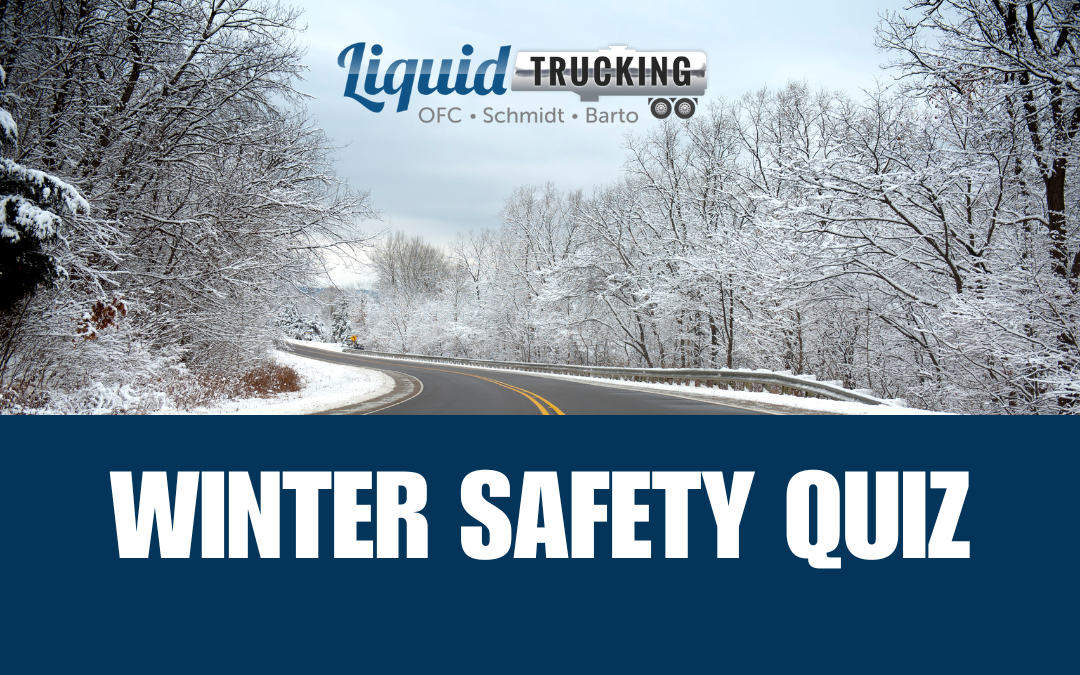Please read through the material below.
Make sure to watch the videos and access all of the links to other materials in each section.
Once you have completed the material, click the link to take the quiz
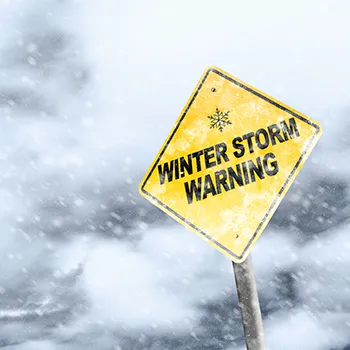 Tips & Tricks
Tips & Tricks
It is no secret that we will receive severe winter weather on multiple occasions during the winter months in various locations you operate. Be prepared for the worst. Try to fuel your truck regularly in the event you are stranded in a traffic backup for extended periods. The roads could be icy, with blowing snow and high winds at times. Please do your best to slow down and make good judgment calls when you can or cannot drive any longer. Make sure to have warm clothing on hand in case you get stranded. Stock your truck with extra fuel treatment, extension cord, plan for a place to plug in your truck if you park off-site, extra fuel filters / a wrench to change the fuel filter, propane torch / extra propane refill bottle (never leave the striker attached to the bottle when stored in your truck) Make sure you have chains, tire socks or both. It’s also crucial that you drain your air tanks weekly to keep moisture from freezing in air tanks. Always check that your breaks are free when taking off as not to flat spot tires.
Below are a few common issues we face in the freezing conditions that cost us time and money. However, with extra precautions, these issues can be avoided. Therefore, please utilize these safety tips and precautions during the upcoming winter months:
Always double-check – that your fifth wheel has completely latched when hooking trailers. You have to physically push in the pin a lot of the time to get it to lock in the wintertime. Always perform a tug test.
Extra caution is to be taken when picking up trailers that came out of wash bays – These trailers get pulled out of the wash bay where everything is wet.
- Are the brakes frozen? You may need to bang on the brake drums with a hammer.
- Try backing up with the trailer brakes released to see if you can knock them loose before pulling forward.
- Is your pump frozen? Grab one end of a PTO shaft and hook it to the pump spud during your pre trip.
- Can you turn it by hand? If not, you may need to pull it in the wash bay to be thawed out.
- Your torch can also handle this in most cases.
- Are the internal/external valves frozen? Make sure you test their operation before leaving with a trailer.
Terminal fuel in Plattsmouth or South Sioux City will always be blended and pretreated during cold weather, so no need to add when fueling at one of the terminals.
Frozen brakes ruin tires almost immediately – Always double-check that your wheels are turning before taking off. If they are not turning, tap the brake drum with a hammer to release the brakes.
When loading a temperature-sensitive product – be sure it is loaded at the correct temperature. First, you have to check for yourself. If it is not warm enough, notify dispatch. If you are not sure if it is warm enough, call your dispatcher. We have to take precautions to avoid turning a warm liquid product into a cold, solid product. Our insulated trailers lose about 6 degrees of temperature per day. If the product is loaded warm enough, you put yourself in a much better position to avoid problems. Additionally, some loads will require in-transit heat. If you need in-transit heat and don’t know how to use it, call dispatch. They will help get you set up. In-transit heat takes 5 or 6 hours to start doing its job in keeping the product warm. It will not heat the product. Be sure to run your in-transit heat right away if it is required. Do not wait until later. Learn more by viewing this video
In snow and icy conditions – walk slowly and watch where you are walking. Please do not get in a hurry so that we can avoid slips and falls. Use 3 points of contact when climbing on any surface. Make sure you are wearing proper footwear for the weather.
Be sure your fuel is treated – to the coldest temperature you expect to encounter. The fuel you get at the yard and at in-network fuel stops is pre-mixed with #1 Diesel. That helps, but you need to treat your tank with a fuel additive on top of that. We use Arctic Blast here at the yard. Howe’s, Power Service, or other brands will work as well. Just make sure it is treated for the temperature you will be experiencing. Check the weather forecast along your route. Do not run your fuel too low in the case you become stranded.
In freezing temperatures – you must plug in your truck if you are going to shut it down for an extended period of time. The truck shop has extra extension cords if you need one. Also consider shutting of your master power switch if away for an extended period of time.
It is our responsibility to let our customers know – if we are going to be late for pickup and delivery times or windows. Please let your dispatcher know you will be late as soon as you can so they can notify our customers. Generally, our customers are upset when we show up late without calling ahead. When customers are upset, they will find somebody else to do the job. If we call them to let them know, we have done the best we can.
Inspect Your Tractor and Trailer – Check the tire pressure, battery, fluid levels, lights, exhaust pipe, and defrosters daily before you hit the road. Make sure your lights are turned on so other motorists can see you. Keeping the rubber caps on hydraulic fittings and In-Transit heat can make a big difference and save a lot of time for the customers.
SLOW DOWN – Most accidents occur because drivers don’t adjust their speed according to the road conditions. For example, while driving on a snow-covered road, you may need to compensate for the poor traction by reducing your speed. Moreover, going slow will also give you more time to react if anything goes wrong.
Leave Extra Stopping Distance – Leave twice the stopping distance when traveling on snow-covered or potentially icy roads. Also, leave twice the amount of space as you normally would when traveling on potentially hazardous roads.
Finding a Safe Haven – If you feel uncomfortable with the road conditions, find the nearest safe haven and get off the road. Be sure to update your dispatcher and continue to evaluate the road conditions as necessary.
Extra Clothing, Food, and Accessories – Make sure to always have extra warm clothing and food in the truck during winter months. Being prepared by having extra warm clothing and food in the truck on a weekly basis can be a lifesaver. Always make sure to have extra warm clothing, a winter jacket, hat, gloves, insulated socks, extra blankets, fuel additive, windshield washer fluid, phone charger, flashlight, batteries, shovel, and a propane torch.
Clean the Ice and Snow – Keep the Windshield defrosted. Make sure the mirrors, windows, and lights are not obstructed by ice or snow.
Watch for Bridges, Exit, and Entrance Ramps – These areas will freeze first and be extra slippery. So slow down and take everything SLOW!
Keep an Eye on Your Trailer Tires – Watch your trailer tires often, especially when you’ve just hooked up to a trailer. Remember, when the last driver dropped that trailer, the brakes were warm. Make sure the wheels are turning and not frozen. Always check that your trailer brakes are free when taking off as not to flat spot tires. Extra caution is to be taken when picking up trailers that came out of wash bays. Trailers get washed in a warm, wet environment, then parked outside in freezing temperatures. The brakes are going to be frozen a lot of the time. Drivers need to be able to use a hammer to free up those frozen brakes. If you cannot get your brakes free, contact the trailer shop or anybody here at the yard for help.
Keep your Fuel Tank Topped Off and Blended – Helps prevent the fuel from freezing and provides extra weight over the drive tires, which helps to give extra needed traction. Winter storms can shut down roads, close gas stations, and compromise fuel levels.
Plan Your Trip With Weather in Mind – Planning and being prepared for any weather you may incur during your trip is essential, especially during the winter months. Make sure to look for the most efficient route while keeping potential weather hazards in mind. Be sure to check for weather advisories or warnings in all areas you encounter during your trip and plan ahead.
Avoid Stopping on the Shoulder – Avoid stopping onto the shoulder of the highway because another motorist may mistake you for a moving truck or could potentially slide into you or the equipment.
Thank you all in advance for taking these extra precautions during freezing conditions. Following this advice will save you many headaches this winter.
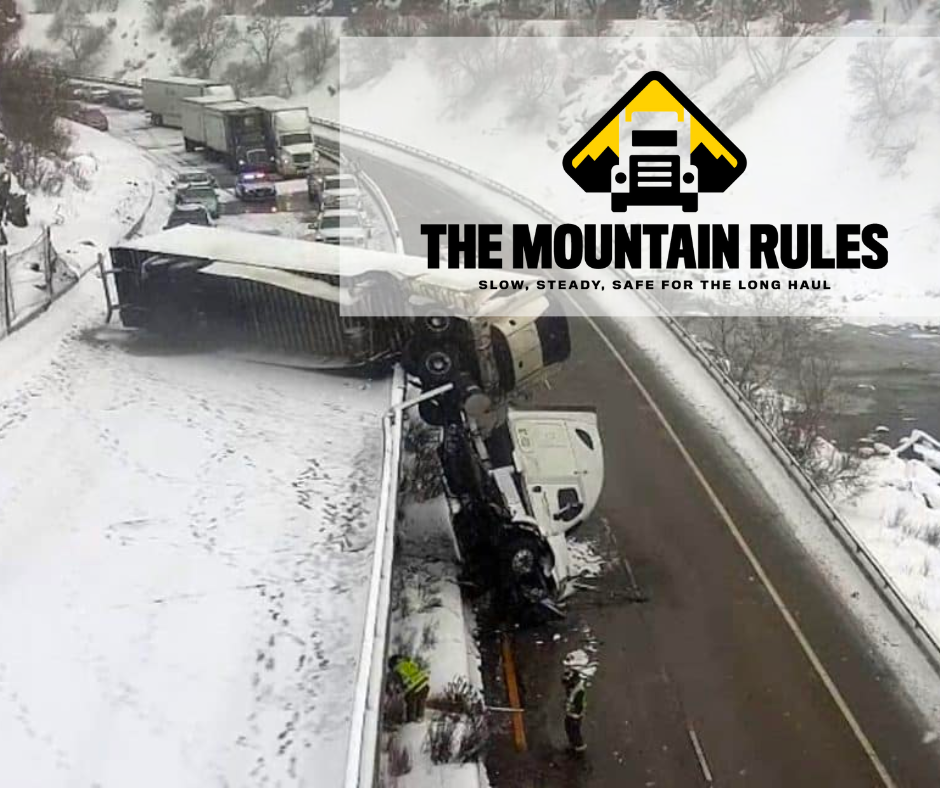 About The Mountain Rules Campaign
About The Mountain Rules Campaign
Colorado’s high elevation and topography can be challenging and require motorists to proceed with extra caution. Truckers have it especially hard in the mountains. When driving a vehicle that’s up to 70 feet long and weighing up to 80,000 pounds, the terrain along the mountain corridor can increase the likelihood of brake failure.
Colorado experiences severe weather events that make driving difficult in the mountains, with high winds and storms that can bring extreme snow and hail. Colorado is also susceptible to hazards such as rockfalls, fires, and floods. All of these elements can cause additional challenges and problems for trucks along the I-70 Mountain Corridor.
The Colorado Department of Transportation, in partnership with the Colorado State Patrol, Colorado Motor Carriers Association, in-cab driver alert providers, PrePass Safety Alliance, and Drivewyze, have a shared aim to help enhance safety for truckers traveling through the state’s mountainous areas.
Through this shared aim and resulting coordinated approach, The Mountain Rules was born. This program is a comprehensive, strategic, and safety-focused effort to inform and educate in-state and inter-state trucking companies and drivers on driving challenges in Colorado’s mountains. It includes information on preventing and avoiding hazards, resources to consider, and a consistent reminder to drive slowly and steadily to be safe for the long haul. WATCH MOUNTAIN RULES SAFETY VIDEO
Season Information
This is an excellent resource for all seasons. The summer Driver Safety Video offers information on Avoiding hot brakes, Steep grade locations on I70, Brake check areas, Runaway truck ramps, and more. WATCH SUMMER VIDEO
The winter safety video offers information on Sudden mountain weather changes, driving etiquette, and tire chain requirements. WATCH WINTER VIDEO
Goals & Objectives
In addition to an educational effort, The Mountain Rules consists of infrastructure and informational improvements, including:
- Signing eastbound Interstate 70 and all eastbound chain stations east of the Eisenhower/Johnson Tunnels with information on the brake check locations for truckers.
- Restriping the wide eastbound exit ramp at the Genesee Park Interchange into a more defined short-term truck parking area where overheated brakes can cool down and equipment checks can take place before the final descent into the Golden area.
- A new subscription-based, in-cab alert system, warning truck drivers about specific areas where brake failures could occur and the location of brake check and runaway truck ramps.
HELPFUL LINKS FOR COLORADO INTERSTATES
- Bridge Weight Limits
- Escort Requirements
- Hazardous Materials Routing
- Longer Vehicle Combinations (LVC) Restrictions
- Oversize/Overweight Restrictions
- Rest Areas/Welcome Centers
- Runaway Truck Ramps
- Truck Stops
- Vertical Clearances
Safety is our top priority at Liquid Trucking. Please visit our YouTube channel for more helpful safety information. Or contact us with any questions.
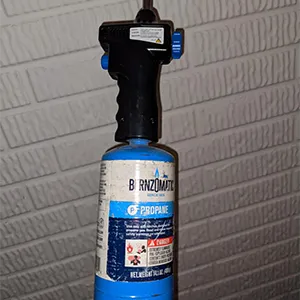 DO YOU HAVE A TORCH IN YOUR TRUCK?
DO YOU HAVE A TORCH IN YOUR TRUCK?
 SafeTravelUSA
SafeTravelUSA
This website will link you to each state’s DOT website for up to date road conditions & more.
SafetravelUSA.com is a service offered by Iteris, Inc. To find a site specific weather forecast along your travel route, please begin by selecting a participating state from the map above or the following table. * Denotes Iteris 511 Systems Site…
In-transit heat training video
When you are hauling a load that requires in-transit heat (fats, tallow, vegetable oils, products that turn solid when cold), It is your responsibility to hook up and run heat until the load has been delivered. When you hook a trailer before leaving the lot, you must inspect that the in-transit lines are charged, hooked up correctly, and fully operational. Before leaving the lot, let your truck idle for a few minutes, and then check your coolant level. Do not leave until your truck has plenty of coolant. Always carry a couple of gallons of extra anti-freeze in your truck in case the trailer is not fully charged. Make this part of your pre/post-trip inspections on every load. If the trailer is not primed, it takes about 8 gallons total. Most regional drivers will carry 3 gallons at minimum with them. Reminder that this must be tracked to be charged out of inventory. Please put gallons and the truck number on the inventory board outside the parts room. If you have questions, please call your dispatcher, and they can help you. Heel charges are very costly, and not running heat when required costs the company thousands of dollars each time it happens. It also costs our drivers a lot of valuable time. Please do your part and be proactive with inspecting your trailers.
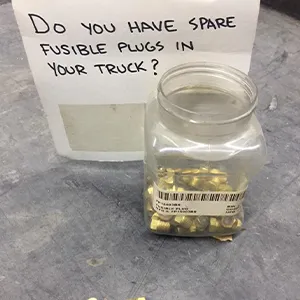 “Fusible Plugs”
“Fusible Plugs”
Be sure to carry a couple extra “Fusible Plugs” in your truck with you, this can save us a lot of time and money on the road if you need one when you pull up to fill your trailer and your current one was melted out by the last washout. We have had to pay as much as $200 on the road for this $2 part. Extra plugs are available from the shop at both terminals.
Trailer Hook Up Procedure
The Wash Bay staff needs your help to be successful. Before leaving any wash bay, please make sure the four bolts on the plate’s back are tightened with a wrench but not too tight. We are finding these bolts are only fastened to hand tight by other wash bays around the country, which causes us to lose parts down the road.
If you use a hose, please do not place the food-grade bag back onto the hose. Putting the bag back on the hose leads wash bays around the country to assume that the hose is clean. Instead, please throw the bags away after the hose is used.
We continue to have issues with seals being knocked into the trailer, which ruins the internal valve. The cost to repair the internal valves is approaching $1000 each. Please do your best to clean up all of the seals left in the crow’s nest of the trailer you are using. If everybody cleans these up and throws the seals away, we will likely have fewer issues with ruining the internal valves because of seals falling into the tank.
When you are finished unloading, be sure to clear the line, including hoses. Failure to clear your lines and hoses leads to big problems for the next driver during the winter in freezing temperatures.
Speaking of colder weather, please shut the lid on the trailer to keep the leftover product or residue warmer and wetter when you are finished unloading. It saves us time and money when washing out these trailers when the product is not frozen and dried out. So please do us a favor and shut the dome lid when you are finished.
>>> CLICK HERE TO TAKE THE QUIZ<<<
